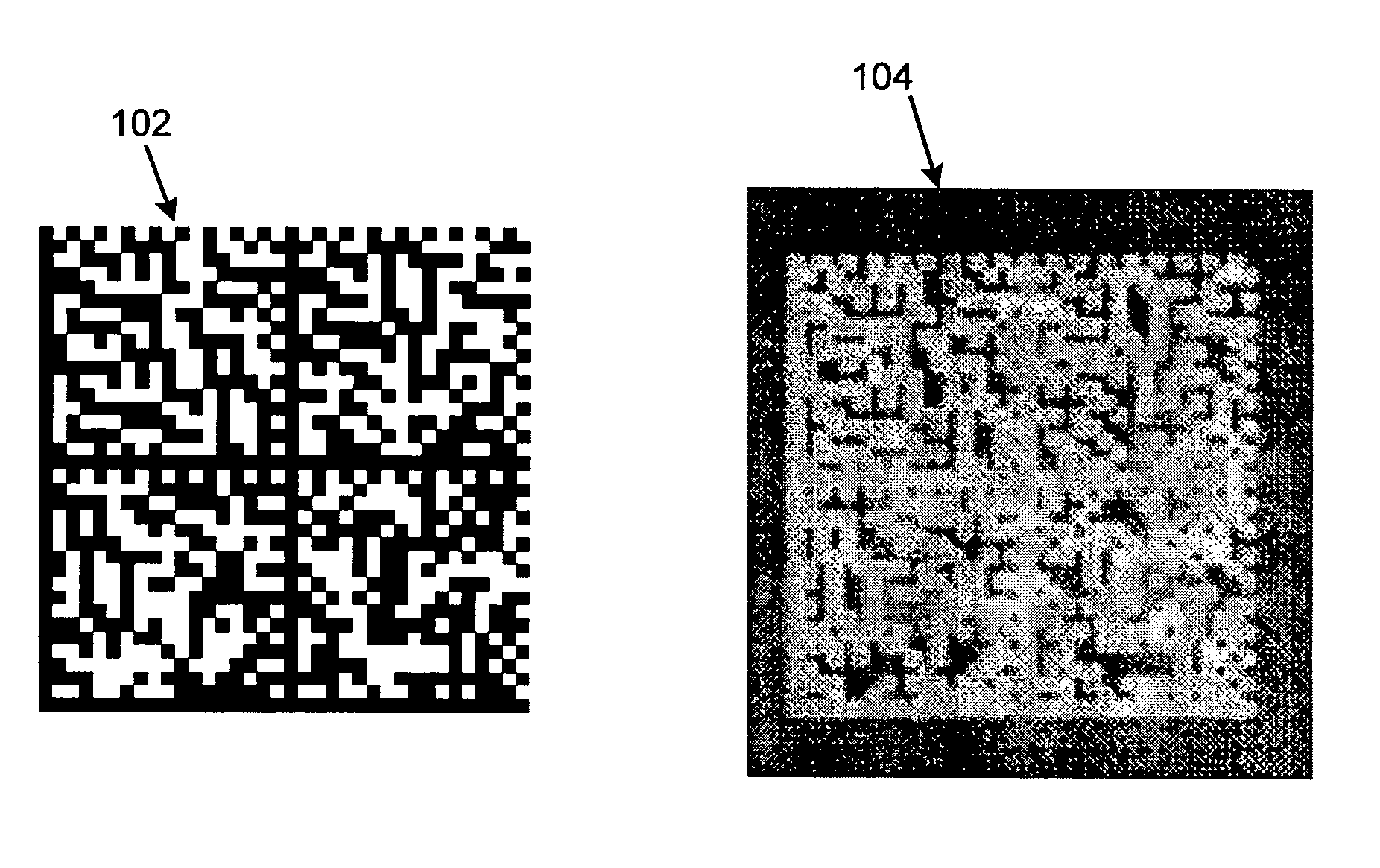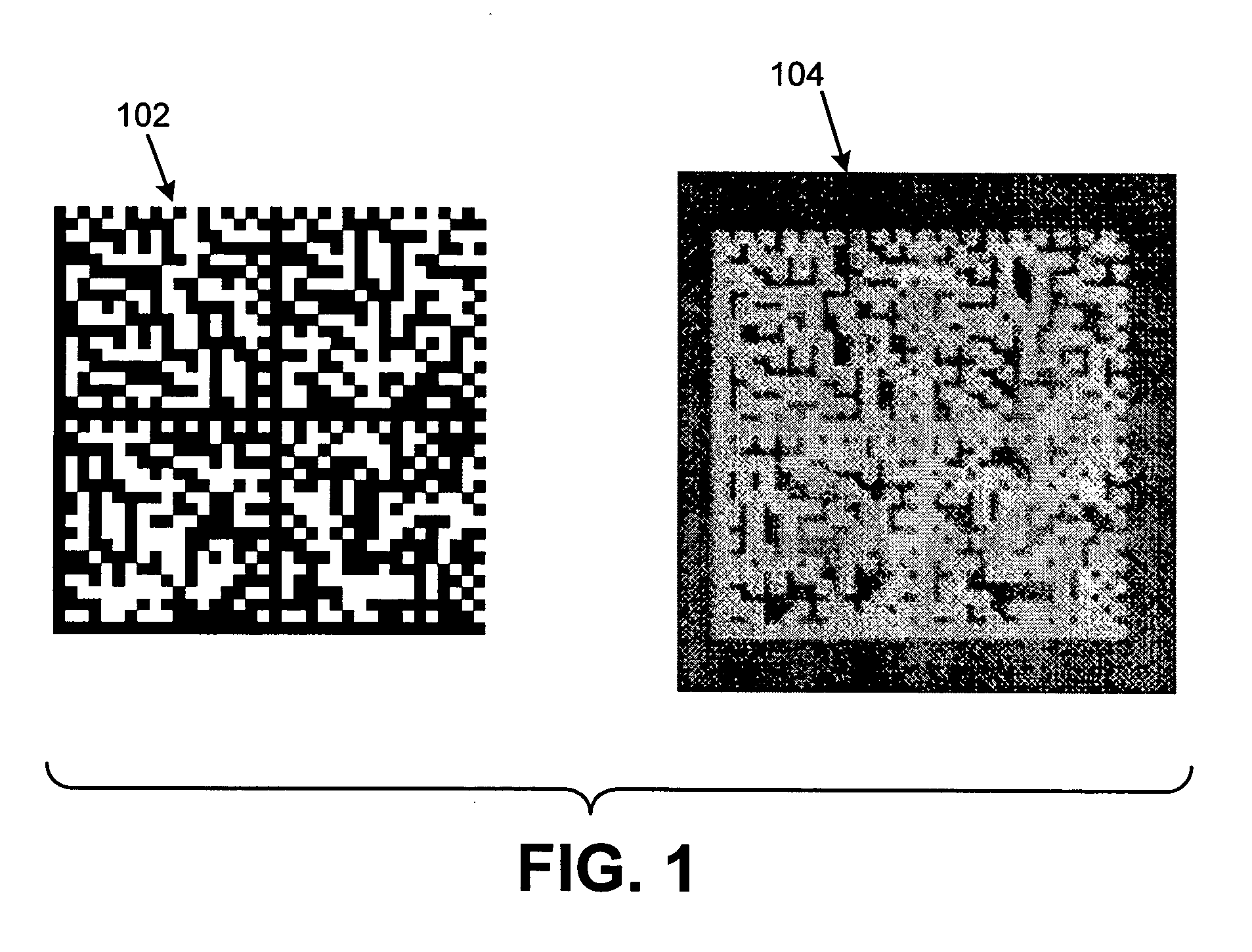[0026] The POV inks of the invention can be used to produce security markings by
digital printing, especially through
inkjet printing. They can also be used in other printing technologies. It is an
advantage of the invention that the new black fluorescent inks of the invention possess low viscosities applicable in thermal inkjet and yet provide printed images with good water fastness. The new concept of formulation employs red fluorescent dye mixtures with longer wave length absorbing pigments, preferably colloidal blue pigments, alone or with dyes.
[0027] For the purposes of the invention, a photosensitive optically variable (POV) ink is an ink that produces a visible, dark print that fluoresces when excited with a shorter
wavelength light such as
ultraviolet light. The patent publication documents identified in
paragraph [0021] above describe POV inks. As used herein, the POV inks of choice will preferably provide a printed image that is visually dark, e.g., black or dark gray, and contains a
machine-readable information-bearing marking that fluoresces in a specific
wavelength range when excited with a shorter wavelength light. Images printed with POV inks exhibit light absorption throughout the entire
visible spectrum including the red region of the
visible spectrum where red inks are invisible to typical automatic scanning systems. These inks will achieve acceptable PCS (Print Contrast
Signal) on dark papers such as Kraft or Manila as well as on white and light-
colored substrates. The Print Contrast
Signal (PCS) is the ratio of the Print Reflectance Difference (PRD) and the substrate reflectance. The difference between the paper reflectance and ink reflectance is the PRD. These terms are given their meanings as defined by the USPS.
[0028] The inks of the invention will comprise at least two distinct colorant portions to achieve the objectives. A first colorant potion will comprise a fluorescent dye emitting light within a characteristic
emission band when excited by fluorescent-exciting
radiation.
Red fluorescence is preferred. The fluorescent dye will be present in the formulation in concentration effective to provide both a necessary contribution to the visible color of the ink and to provide a
machine detectable fluorescent image. Among the suitable fluorescent dyes for the first colorant are those dyes meeting the objectives herein described in U.S. Patent Publication No. 2002 / 0195586.
[0029] The preferred
water soluble fluorescent dyes are characterized by
red fluorescence and a suitably intense visible color to provide a
dark color to the ink in the ink composition. The most preferred of this class have visible colors
ranging from red to green and fluoresce by emitting light within the range of from 390 to 680 nm. Preferred yellow or orange fluorescent dye components (FY) may be based on the chromophoric systems such as anionic coumarins, cationic coumarins, anionic naphthalimide dyes, pyranine (anionic
pyrene dye), neutral, anionic and cationic
perylene dyes, and anionic
xanthene dyes. Some preferred yellow or orange fluorescent dyes are anionic coumarines, cationic coumarines, courmarine
sulfonic acid, anionic napthalimide, neutral
perylene, cationic
perylene, anionic pyronine, and anionic napthalimide dyes, as illustrated for example in FIG. 13 of U.S. Patent Publication No. 2002 / 0195586. Among the useful red and purple fluorescent dyes are anionic
xanthene dyes, bispyrromethane
boron complexes, cationic and zwitterionic pyronines and sulphorhodamine B (SRB), as illustrated for example in FIG. 14 of U.S. Patent Publication No. 2002 / 0195586. Acid Red 52 is a suitable water-soluble
magenta dye. Acid Red 52 dye has satisfactory
solubility in water but a very low water fastness as normally employed. Thus, a
disadvantage of the
magenta Acid Red 52 dye is that the ink containing such dye bleeds when exposed to water. Also, prints obtained with these inks offset on the back of neighboring envelopes when exposed to water, and the offset prints show an increased fluorescent
signal. The
dilution of fluorescent imprints on certain envelopes could enhance the fluorescent
signal. Therefore, current
magenta inks experience background offset
fluorescence. This can cause matter that is not an indicia to appear as an actual indicia printed on an envelope. Because the inks of the invention use concentrations of only from about 0.1 to about 2.0%, more narrowly, from 0.25 to 1.0%, by weight of this component in the ink composition as used in the final inks, any loss of definition due to water
wetting after printing by
inkjet printing is surpassed by the ability of the ink to penetrate the substrate as part of the composition of the invention. Also among the useful yellow and orange dyes are acid yellow 7,
coumarin sulfonic acid, cationic coumarins, anionic coumarins, neutral, anionic and cationic perylene dyes, anionic naphthalimide dyes and pyranine dyes. An important feature of these dyes is their ability to form a dark
colored ink with good fluorescent properties.
[0030] In order to achieve a black ink, the dye and
pigment mixture of the invention must absorb across the entire
visible spectrum, from 390 nm to ca. 680 nm. To obtain simultaneous
red fluorescence in
ultraviolet light in the desired region of 580-630 nm, the composition must absorb
fluorescence exciting
radiation, e.g., UV light, efficiently and fluoresce efficiently, preferably between 580 and 630 nm. The first colorant dye (or dyes) is selected to meet these criteria in combination with the second colorant of the invention which comprises a colloidal
pigment alone or with a dye having a light
absorption band at longer wavelengths than the characteristic emission band of the first colorant or also overlapping the emission wavelength of the first colorant in such a way as to result in a
dark color, preferably black. The second colorant will be present in the formulation in concentration effective to provide a necessary contribution to the visible color of the ink without preventing
machine delectability of the fluorescent image. The inks of the invention typically employ the second colorant at concentrations (based on the weight of dry solids) of from about 1 to about 5%, more narrowly, from 2 to 4%, by weight of this second colorant in the ink composition as applied. The dyes and / or pigments will have characteristic penetrations into paper and preferred members of the group will not significantly lose definition due to water
wetting after printing by
inkjet printing.
[0031] Among the colorants suitable for use in the second colorant of the inks of the invention are the
water dispersible colloidal pigments, as described, for example, in U.S. Pat. No. 6,494,943 to Yu, et al. The pigments described broadly by the Yu, et al. patent are identified as
colored pigments having one or more desired parameters and / or properties are described. These parameters and / or properties include: a) a particles size of from about 10 nm to about 300 nm; b) an accusizer number of less than 1010 particles / ml of dispersion at 15% solids which are greater than 0.5 micron; c) a filterability such that when in a
liquid medium, 100 ml having 10% solids of the colored pigment filters through a 3 micron nylon absolute filter; d) a colored pigment purity of greater than about 80%, based on extractable material; and / or e) a stability such that the above-described properties do not change by more than 50% at 25° C. for at least one week. Similarly, the preferred pigments of the invention can be characterized as having one or more of these properties. In addition to these pigments are those that require dispersants to remain stable. Among preferred colloidal pigments are those available from Cabot Corporation as Cabot Blue
Pigment Dispersion, Cyan COJ 250 and from Degussa as R-4071 Blue
Pigment Dispersion. Pigments like these will not bleed to the extent of dyes, yet in the formulations of the invention will provide a penetration and water fastness highly desirable for security and other value metered markings, as POV inks.
 Login to View More
Login to View More 

